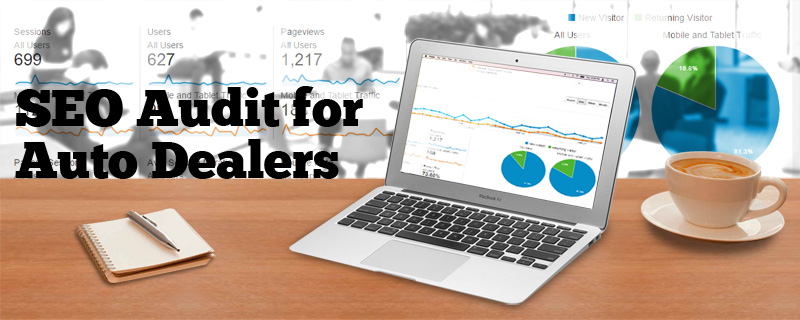
The first step to fixing any problem is realizing that there is one. You can’t improve the effectiveness of your auto dealer website SEO if you don’t know what needs work. This article is meant to help your auto dealership get an idea about where to start when conducting an SEO audit. SEO audits have the potential to boost rankings on Search Engine Response Pages (SERPs) and increase sales for any car dealer. Your dealership should conduct SEO audits regularly since things are always changing in the world of SEO and the auto industry. This can increase the success of your car dealership in many ways.
1. Start with a crawl
The first step in your SEO audit is to do a crawl of your car dealer website. There are several free and affordable tools that you can use for this step. You should also see what Google indexes when you search for your domain. To do this, search in Google “Site:http://www.YourSite.com” and analyze what comes up. Do the results reflect what your dealership wants to be associated with? If not, consider what you can change so that the results are more accurately related to your dealership.
2. Speed
Next is your dealership website’s speed. Site speed is a huge ranking factor for SERPs. If it takes too long for online visitors to load your page, they might give up and go to another auto dealership’s website. As site speed increases, the bounce rate decreases which is great for your dealership. People are searching for more and more convenience now, so fast loading pages are crucial. There are several ways to measure your site speed, but Google PageSpeed Insights is one of the more useful ones. It will tell you how fast your pages load on both desktop and mobile.
3. Site structure
The structure of your car dealer site has an impact on users’ experiences and how well bots can interpret your website. Therefore, having an accurate sitemap is very important. It should be easy for visitors to get from your Home page to any other page that they’re interested in. It shouldn’t take users 5 clicks to get to their desired destination. Navigating your main menu and submenu pages should be straightforward and prioritized by importance. Another aspect of site structure has to do with URLs. Your dealership site’s URLs should describe the page you’re on simply with few numbers or symbols. This makes it easier for users and bots to figure out what each page is about.
4. Review content
Content on your website is one of the most important SEO factors for Google. Make sure that the content you provide for your visitors is unique and useful for searchers. The optimal length for each piece in terms of SEO is around 1,000-2,500 words. Search for content gaps on topics that you haven’t covered yet. When you fill the gaps with valuable content, you’ll get more traffic and engagement from potential car buyers. Keywords are another aspect of content. Find out how your pages rank for different keywords. Then, use the Google AdWords Keyword Planner to find possible new keywords to focus on. Are the keywords you currently rank for the ones that your dealership wants to capture? Your keywords should be natural phrases that are relevant to each article so that it’s clear what your content is about.
5. Tags
All the tags on your auto dealer website have an influence on SEO. You should keep your title tags just long enough to describe the page it’s on. Short, relevant title tags with some keywords rank the best. Avoid keyword stuffing in any of your tags. Meta-tags that describe webpages help online users more easily navigate your website. Image alt-tags help bots understand what your pictures are about, so make sure to relate them to the images.
6. Links
Links are very important for SEO. Broken links should be fixed. Backlinks should be chosen with care. You should have internal links that encourage visitors to stay on your auto dealership’s website. Internal links also make it easier for users to find information they’re looking for faster. This can increase customer satisfaction and decrease the bounce rate. Bad links have a negative impact on your SEO rankings, so be sure to pay close attention to the sites you’re linking your website to.
7. Social media
You should test how difficult it is to get to your car dealership’s social media pages by using a search engine. Type in “your auto dealership’s name + the social media platform you want to test” to see what the results are. For example, “AutoJini’s Cars + Facebook.” Can interested people find your social media pages easily? If not, you have some work to do. Once your pages show up in the results, make sure to check whether the information is correct. You should be updating your social media as things at your auto dealership change. Your Contact Us and About Us sections are some of the sections on social media pages that you should be updating regularly so that they match your website’s information.
SEO audits take time when you do them right and evaluate how to proceed from there, but they can have huge impacts on your dealership’s success. When your website is ranking, correct, and easy-to-use, you get way more online traffic than when you just make an update every once in a while. Follow these steps and use a few of the many SEO tools available for little or no money to see great results for your auto dealership.

